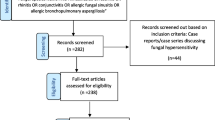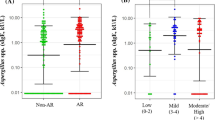Abstract
For decades airborne fungal spores have been implicated as causative factors in respiratory allergy. Exposure to high atmospheric spore counts and sensitization to specific fungal allergens have been associated with severe asthma, mainly in young adults. Although the prevalence of sensitization to commercial fungal extracts is approximately 3% in epidemiologic studies, in selected patients, particularly with asthma, the sensitization rate might increase to 30%. Of the estimated number of more than 1 million of different fungal species, approximately 80 fungi have been connected with respiratory allergy. Currently, diagnosis and specific therapy of fungal allergy is hampered by the poor quality of most of the commercially available extracts. Clinical efficacy of specific immunotherapy with fungal extracts has been shown in 79 actively treated patients in four controlled trials, with only two fungal species, namely Alternaria alternata and Cladosporium herbarum. The use of recombinant fungal allergens might create new prospects in diagnosis and specific immunotherapy for fungal allergy.
Similar content being viewed by others
References and Recommended Reading
Noon L: Prophylactic inoculation against hay fever. Lancet 1911, 1:1572–573.
Möller C, Dreborg S, Ferdousi HA, et al.: Pollen immunotherapy reduces the development of asthma in children with seasonal rhinoconjuncitivits (the PAT-Study). J Allergy Clin Immunol 2002, 109:251–256.
Des Roches A, Paradis L, Menardo JL, et al.: Immunotherapy with a standardized Dermatophagoides pteronyssinus extract: specific immunotherapy prevents the onset of new sensitizations in children. J Allergy Clin Immunol 1997, 99:450–453.
Jacobsen L, Nuchel PB, Wihl JA, et al.: Immunotherapy with partially purified and standardized tree pollen extracts. IV. Results from long-term (6 years) follow-up. Allergy 1997, 52:914–920.
Durham SR, Walker SM, Varga EM, et al.: Long-term clinical efficacy of grass-pollen immunotherapy. N Engl J Med 1999, 341:468–475.
Bousquet J, Lockey RF, Malling HJ: WHO Position Paper: Allergen immunotherapy: therapeutic vaccines for allergic diseases. Allergy 1998, 53(Suppl):1–42.
Blackley CH: Experimental Researches on the Causes and Nature of Catarrhus aestivus (Hay Fever or Hay Asthma). London: Baillière, Tindall and Cox; 1873.
Cadham FT: Asthma due to grain rusts. JAMA 1924, 83:27.
von Leeuwen WS: Bronchial asthma in relation to climate. Proc Roy Soc Med 1924, 17:19–26.
Salvaggio JE, Seabury J, Schoenhardt E: New Orleans asthma. V. Relationship between Charity Hospital asthma admission rates, semiquantitative pollen and fungal spore counts, and total particulate aerometric sampling data. J Allergy Clin Immunol 1971, 48:96–114.
Horner WE, Helbling A, Salvaggio JE, Lehrer SB: Fungal allergens. Clin Microbiol Rev 1995:8:161–179.
Peat JK, Tovey E, Mellis CM, et al.: Importance of house dust mite and Alternaria allergens in childhood asthma: an epidemiological study in two climatic regions of Australia. Clin Exp Allergy 1993, 23:812–820.
Neukirch C, Henry C, Leynaert B, et al.: Is sensitization to Alternaria alternata a risk factor for severe asthma? A population-based study. J Allergy Clin Immunol 1999, 103:709–711.
O’Hollaren MT, Yunginger JW, Offord KP, et al.: Exposure to an aeroallergen as a possible precipitating factor in respiratory arrest in young patients with asthma. N Engl J Med 1991, 324:359–363.
Targonsky PV, Persky VW, Viswanathan R: Effect of environmental molds on risk of death from asthma during the pollen season. J Allergy Clin Immunol 1995, 95:955–961.
Black PN, Udy AA, Brodie SM: Sensitivity to fungal allergens is a risk factor for life-threatening asthma. Allergy 2000, 55:501–504.
D’Amato G, Spieksma FThM: Aerobiologic and clinical aspects of mould allergy in Europe: position paper. Allergy 1995, 50:870–877.
Horner WE, Helbling A, Lehrer SB: Basidiomycete allergens. Allergy 1998, 53:1114–1121.
Helbling A, Brander KA, Horner WE, Lehrer SB: Allergy to basidiomycetes. In Fungal Allergy and Pathogenicity: Chemical Immunology, vol 81. Edited by Breitenbach M, Crameri R, Lehrer S. Basel: Karger; 2002:28–47. Overview of the current clinical data on basidiomycete allergy, including the most recent research findings on basidiomycete allergens.
Burge HA: Un update on pollen and fungal spore aerobiology. J Allergy Clin Immunol 2002, 110:544–52. Excellent review on fungi describing all requirements for fungal growth and occurrence, including new and established analytical methods for the detection of fungal components.
Kurup VP, Shen HD, Vijay H: Immunobiology of fungal allergens. Int Arch Allergy Immunol 2002, 129:181–188.
Turkeltaub PC, Kovar MG: The prevalence of allergic skin test reactivity to eight common aeroallergens in the US population: results from the second National Health and Nutrition Examination survey. J Allergy Clin Immunol 1987:80:669–679.
Wüthrich B, Schindler C, Leuenberger P, et al.: Prevalence of atopy and pollinosis in the adult population of Switzerland (SAPALDIA study). Int Arch Allergy Immunol 1995, 106:149–156.
Tariq S, Mattews S, Stevens M, Hakin E: Sensitization to Alternaria and Cladosporium by the age of 4 years. Clin Exp Allergy 1996:26:794–798.
Lehrer SB, Hughes JM, Altman LC, et al.: Prevalence of basidiomycete allergy in the USA and Europe and its relationship to allergic respiratory symptoms. Allergy 1994, 49:460–465. In this multicenter study, it is revealed that Basidiomycetes might be important sources of aeroallergens in geographically disparate regions, particularly for patients with asthma.
D’Amato G, Chatzigeorgiou G, Corsico R, et al.: Evaluation of the prevalence of skin prick test positivity to Alternaria and Cladosporium in patients with suspected respiratory allergy: a European multicenter study promoted by the Subcommittee on Aerobiology and Environmental aspects of inhalant allergens of the EAACI. Allergy 1997, 52:711–716. This study shows the variability of skin test reactivity to the two most commonly used fungal extracts of Alternaria and Cladosporium in various European countries among patients with suspected respiratory allergy.
Niemeijer NR, De Monchy JG: Age-dependency of sensitization to aero-allergens in asthmatics. Allergy 1992, 47:431–435.
Horst M, Hejjaoui A, Horst V, et al.: Double-blind, placebocontrolled rush immunotherapy with standardized Alternaria extract. J Allergy Clin Immunol 1990, 85:460–472. This study shows the difficulty to recruit monosensitized subjects to a single fungal species. Moreover, this double-blind, placebo-controlled immunotherapy trial showed clinical efficacy of a standardized Alternaria extract in the actively treated group.
Crameri R: Molecular cloning of Aspergillus fumigatus allergens and their role in allergic bronchopulmonary Aspergillosis. In Fungal Allergy and Pathogenicity: Chemical Immunology, vol 81. Edited by Breitenbach M, Crameri R, Lehrer S. Basel: Karger; 2002:73–93. This article covers the comprehensive knowledge of a robotic-based highthroughput screening technology to obtain pure, fully characterized recombinant Aspergillus allergens. The clinical implication of recombinant allergens is outlined in a summary of all the in vivo and in vitro large-scale studies with recombinant Aspergillus fumigatus allergens.
Burge HA: Fungus allergens. Clin Rev Allergy 1985, 3:319–329.
Aden E, Weber B, Bossert J, et al.: Standardization of Alternaria alternata: extraction and quantification of Alt a 1 by using an mAb-based binding assay. J Allergy Clin Immunol 1999, 104:128–135. An assay for the quantification of Alt a 1 and its use for improved standardization of Alternaria alternata extracts for in vivo diagnosis is described.
Vailes L, Sridhara S, Cromwell O, et al.: Quantitation of the major fungal allergens, Alt a 1 and Asp f 1, in commercial allergenic products. J Allergy Clin Immunol 2001, 107:641–646. The results of this study using an ELISA-based assay for specific allergens indicate an improved quality control and standardization of fungal allergen extracts in the future.
Moser M, Crameri R, Brust E, et al.: Diagnostic value of recombinant Aspergillus fumigatus allergen for skin testing and serology. J Allergy Clin Immunol 1994, 93:1–11.
Unger A, Stoger P, Simon-Nobbe B, et al.: Clinical testing of recombinant allergens of the mold Alternaria alternata. Int Arch Allergy Immunol 1999, 118:220–221.
Aas K, Leegaard J, Aukrust L, Grimmer O: Immediate type hypersensitivity to common moulds: comparison of different diagnostic materials. Allergy 1980, 35:443–451.
Helbling A, Gayer F, Pichler WJ, Brander K: Mushroom (basidiomycete) allergy: diagnosis established by skin test and nasal challenge. J Allergy Clin Immunol 1998, 102:853–858. This study suggests that sensitization to basidiomycetes is not infrequent. The clinical relevance was shown by active anterior rhinomanometry in Pleurotus pulmonaris-sensitive subjects with respiratory allergy.
Dreborg S, Agrell B, Foucard T, et al.: A double-blind, multicenter immunotherapy trial in children, using a purified and standardized Cladosporium herbarum preparation. Allergy 1986, 41:131–140. The first double-blind, placebo-controlled study demonstrating the clinical efficacy of specific immunotherapy with a purified Cladosporium herbarum extract in children with asthma.
Malling HJ, Dreborg S, Weeke B: Diagnosis and immunotherapy of mould allergy. Clin Effic Allergy 1986, 41:507–519. The first double-blind, placebo-controlled study demonstrating a significant clinical efficacy of the specific immunotherapy with a purified Cladosporium herbarum extract in adult asthmatics.
Cantani A, Businco E, Maglio A: Alternaria allergy: a three-year controlled study in children treated with immunotherapy. Allergol Immunopathol (Madrid) 1988, 16:1–4. First published and controlled immunotherapy study with a standard Alternaria extract showing efficacy in Alternaria-sensitive children.
Tuchinda M, Chai H: Effect of immunotherapy in chronic asthmatic hildren. J Allergy Clin Immunol 1973, 51:131–138.
Goldstein GL, Chai H: Efficacy of rush immunotherapy in decreasing bronchial sensitivity to inhaled antigens in perennial childhood asthma. Ann Allergy 1981, 47:333–337.
Bernardis P, Agnoletto M, Puccinelli P, et al.: Injective versus sublingual immunotherapy in Alternaria tenuis allergic patients. J Invest Allergol Clin Immunol 1996, 6:55–62. The first trial comparing the efficacy and safety of injective immunotherapy and sublingual immunotherapy in Alternaria alternata-sensitized individuals.
Tabar AI, Lizaso MT, Garcia BE, et al.: Tolerance of immunotherapy with standardized extract of Alternaria tenuis in patients with rhinitis and bronchial asthma. J Invest Allergol Clin Immunol 2000, 10:327–333.
Kaad PH, Oestergaard PA: The hazard of mould hyposensitization in children with asthma. Clinical Allergy 1982, 12:317–320.
Busse WW, Storms WW, Flaherty DK, et al.: Alternaria IgG precipitins and adverse reactions. J Allergy Clin Immunol 1976, 57:367–372.
Vijai HM, Huang H, Young NM, Bernstein IL: Studies on Alternaria allergens. IV.Comparative biochemical and immunological studies of commercial Alternaria tenuis batches. Int Arch Allergy Appl Immunol 1984, 74:256–261.
Resano A, Sanz ML, Oehling A: Sensitization to Alternaria and Cladosporium in asthmatic patients and its in vitro diagnostic confirmation. Invest Allergol Clin Immunol 1998, 8:353–358.
Mabry RL, Marple BF, Mabry CS: Outcomes after discontinuation of immunotherapy for allergic fungal sinusitis. Otolaryngol Head Neck Surg 2000, 122:104–106.
Author information
Authors and Affiliations
Rights and permissions
About this article
Cite this article
Helbling, A., Reimers, A. Immunotherapy in fungal allergy. Curr Allergy Asthma Rep 3, 447–453 (2003). https://doi.org/10.1007/s11882-003-0082-x
Issue Date:
DOI: https://doi.org/10.1007/s11882-003-0082-x




